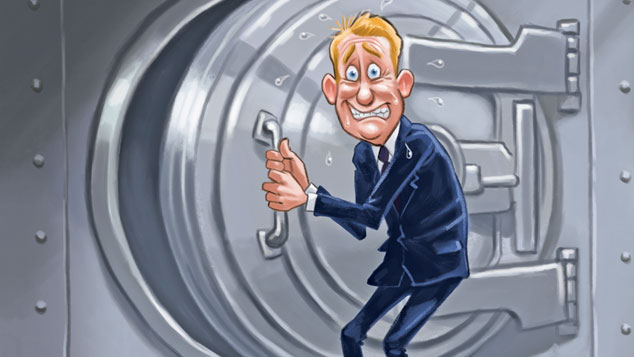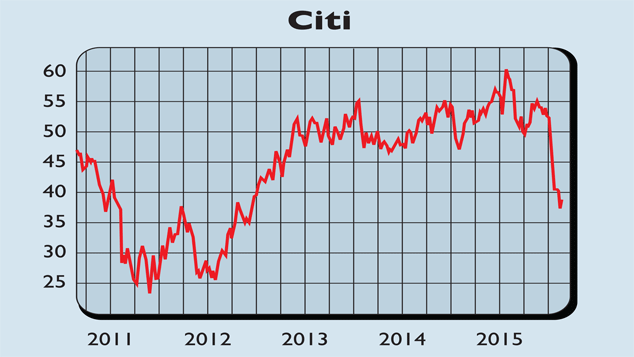How to profit from the big bank sell-off
It’s carnage in the European finance sector – but are things really as bad as they look? James Ferguson takes a look under the bonnet.

The news isn't good and it keeps on coming. European banks are at the epicentre of a global sell-off that has wiped 20%-50% off bank share prices across the developed world over the last three months, from America to Japan, via all points in between. Germany's largest bank, Deutsche Bank long the most highly geared "global systemically important bank" has seen its share price halve.
It is now significantly below its 2009 nadir. Credit Suisse, another big European bank, has a new chief executive who is also "kitchen sinking" bad news that accumulated during his predecessor's tenancy. It has likewise seen its share price dive well below both the 2009 and 2012 lows. This is all happening at a time when sentiment in European banking circles was already near record lows, amid fears last month for the very survival of Italy's oldest and third-largest bank, Banca Monte dei Paschi di Siena.
Politicians and executives have rushed to reassure. But the list of financially complacent quotes on the eve of disaster is a long and comprehensive one. Remember these? "We do not expect significant spillovers from the subprime market to the rest of the economy or to the financial system" (then-Federal Reserve chairman Ben Bernanke,17 May 2007). "Our capital position is strong" (Lehman Brothers' chief financial officer, five days before the bank filed for bankruptcy in September 2008). "We have started 2007 strongly" (Northern Rock CEO Adam Applegarth).
Subscribe to MoneyWeek
Subscribe to MoneyWeek today and get your first six magazine issues absolutely FREE

Sign up to Money Morning
Don't miss the latest investment and personal finances news, market analysis, plus money-saving tips with our free twice-daily newsletter
Don't miss the latest investment and personal finances news, market analysis, plus money-saving tips with our free twice-daily newsletter
So it just makes people even more nervous when Wolfgang Schuble, the German finance minister, says he has "no concerns" over Deutsche, or the bank's new British co-CEO John Cryan assures staff that the bank "remains absolutely rock-solid".
Europe's banks have had a tougher crisis than most. The Euro STOXX Banks index fell by almost as much as the UK and US banks did in 2008/2009. But when the euro crisis struck in 2011/2012, continental banks made new lows, even as Anglo Saxon banks traded at double their 2009 nadirs. Now, seven years on, and for the third time since the financial crisis, euro area banks look in danger of marking new record lows again.
What has triggered this? Only last summer banks around the globe, including Europe, were at four-to-five-year highs. It doesn't help that since 9 December the European Central Bank (ECB) has been charging the banking system a negative interest rate of 0.3% on deposits. This has triggered fears that banks' net interest margins the profit that banks earn on the "spread" between what they pay depositors and others for funds, and what they can charge on loans may be squeezing profitability, just as investment-banking activities have also turned loss-making as markets slide.
This isn't new ECB deposit rates first turned negative last June but it all looks increasingly and relentlessly bleak. On top of that, the oil price has rattled markets, as has China, dollar strength, emerging-market risks, illiquid bond markets, slower growth. The themes are countless (and some should be positives anyway), but only one thing unites and drives them all and that's what we should focus on.
A bitter harvest
The banking crisis has never gone away; it is only the market's perception of how acute it is that waxes and wanes. Resolving a bank crisis such as the one that drove the 2008 crash takes years.
During that period, the extent of the problem occasionally bubbles to the surface. The authorities' reaction is usually to ease monetary conditions to calm market jitters over bank balance sheets until order is restored and prices recover only to go through a whole "new" scare over the scale of hidden losses a couple of years down the track.
So as this is clearly an ongoing problem it pays to have a clear idea of what we are dealing with. The "good" news is that financial crises are actually quite common and follow a fairly reliable pattern, so we can have a rough idea of what to expect. Typically, around 25% of the banking system's loans become non-performing. In other words, of loans outstanding at the peak, about 25% go bad. Banks tend to recover about 60% of the face value of these loans. So we're talking overall average bad debt loss of about 10% for a single country's banking system.
Synchronous crises such as the 2008 crisis are less common and more severe. When these happen, losses typically end up closer to 15%. If you look at the US banks, which now seem to have been nursed back to health, losses have already reached 14.5%, which seems to corroborate this 15% figure.
This is the nub of Europe's problem. The euro area banks, on average, have so far only realised cumulative losses of about 6% of their 2011 loan book, which peaked at €12.3trn. So we can expect maybe another €1trn in hidden loan losses, still to be revealed. The trouble is, that's roughly equivalent to the entire sector's capital. So technically speaking (based on historical precedent), the euro area banking system is still insolvent.
This sounds rather dramatic but it isn't that unusual. Most academics define banking crises as events that, with the benefit of hindsight, involved losses that were a multiple of starting capital.In other words, a banking crisis is what you get when your banks are insolvent. However, the fact is that banks are great cash-generating machines. So even if a bank is insolvent today, just give it time and it'll be back in rude health again in a few years. The critical thing is to make sure that no one gets wind of the extent of the problem until then.
Take a look at America. American banks, according to the International Monetary Fund, held roughly $560bn in capital in summer 2007. By my calculations, they have since endured $843bn of loan losses, $275bn of realised trading losses, and some $280bn of fines. Yet they have still almost doubled their capital base to about $1.1trn. If they had taken the hit to earnings up front, they would have been insolvent several times over.
But by spreading the pain over seven years, US banks were able to match losses against retained earnings and with some notable casualties and mega-mergers along the way achieve full resolution.
The reason euro area banks lag so far behind their American peers in terms of loan loss recognition is that they started out with far less loss-absorbing capital in the first place. As a result, European banks have had to devote more time and retained earnings since 2008 to building up capital than to absorbing losses. This has left them at a distinct disadvantage. European banks also have historically lower margins meaning it takes longer to build up retained earnings.
And of course, scepticism that US subprime would cross the Atlantic didn't help either loans didn't even peak until late 2011, a full three years behind America. Basically, it's better to endure the pain and rip the plaster off, as the US did, than to draw it out and hope for some external solution such as miraculous, rampant growth as Europe did. Unfortunately, Europe didn't have the guts, cohesion, leadership or full understanding to follow America, and is now reaping the bitter harvest.
The threat of a big reveal
So again why the current panic? The factors mentioned above haven't helped. And inconsistencies in the way that Portugal and Italy have recently "bailed in" bondholders to troubled banks won't have calmed nerves either (see below). But the trigger for the latest sell-off could well be something you probably haven't heard of an obscure report from the Financial Stability Board's Enhanced Disclosure Task Force (EDTF) entitled "Impact of expected credit loss approaches on bank risk disclosures".
This is only the second report the EDTF has published since its inception in 2012. Yet its publication on 30 November prefigured the start of the bank sell-off by just 24 hours. Why would it worry investors? Because its recommendations are widely expected to inform the new regulations under International Financial Reporting Standards (IFRS 9). This is the next update to the rules governing how banks must report their risks and impairments, which comes in from January 2018.
The last thing banks need, when they aren't fixed yet and are hiding non-performing loans off balance sheet, is a new set of rules forcing them to tell the world how bad things really are, given that as mentioned above our best-guess estimates suggest there is still around €1trn in bad debt to write off.
Cheap but risky
Yet the outlook, despite what you've read, is by no means all bad. Large European banks, the UK included, are cheap. They now trade at an average of only around 0.6 times book value. That compares to roughly twice book value before the crisis. And while it is possible that European banks' hidden losses, based on historical crisis experience, could presently exceed their capital, book values include intangibles and other non-qualifying capital instruments, so it's unlikely that even under a worst-case scenario, euro-area banks' hidden losses exceed their reported book values.
On top of that, the ECB reckons that banks can generate as much as €350bn a year in pre-provision, pre-tax earnings. That would be sufficient to absorb our hidden losses estimate of €1trn within the next three years.
Given all that, the current valuation for the sector might appear unnecessarily pessimistic. The trouble is, all of this depends on a lot of unknowns: the actual size of hidden losses, how long it'll take for European banks to start lending again (a sure sign that they are fixed), andwhat risks investors run in the interim before balance sheets are finally robust enough once more. And while the sector as a whole looks cheap, picking individual stocks is another matter.
One problem that Europe has now is that national regulators can't always protect national banks as they once could, and so the ECB could decided to make some examples. These are admittedly unlikely to be national champions of the one country (Germany) financing them all, but the risk is who knows? However, as an investor, you don't need to take those risks.
There is one jurisdiction where the evidence strongly suggests that the crisis really is fully resolved, and the banks really are fixed America. Valuations on large banks over there aren't quite so cheap as in Europe on average, they're closer to book value but that's still less than half the pre-crisis norm, and the balance-sheet fundamentals in America really do add up.
Benjamin Graham famously compared the stockmarket to a voting machine in the short-run, but a weighing machine in the longer run. I would paraphrase by saying the stockmarket is all about the profit and loss account in the short term, but all about the balance sheet in the long run. Short term, even American banks will see their earnings in investment banking suffer. They may even seetheir loan margins squeezed, though there's less sign of that since the crisis than many suppose.
But what really matters in the long run is what the balance sheet looks like "under the hood". As far as we can tell, hidden losses in America have virtually allnow been processed. Bad debt provisions have dropped back to pre-crisis trends. Most significantly, banks are lending again, which shows that managers believe it's safe to go back in the water.
In short, for many big US banks, net interest margins, return on assets and bad debt provisions are all back at "normal" pre-crisis levels. But today, the banks sport almost double the quantity of super-safe capital they had then, and after the sell-off, trade at less than half their pre-crisis valuations. On a risk/reward basis, there may never have been a better time to look at the sector. John Stepek looks at two big US banks below, and for the brave, Jonathan Compton gives his views on Europe's banks.
James Ferguson is a founding partner of the MacroStrategy Partnership LLP.
Bail-in confusion

One concern hanging over strugglingEuropean banks is the lack of certaintyover exactly how ailing banks will be"resolved", writes John Stepek. For example, last year theItalian government bailed-in juniorbondholders at four small regionalbanks. Unfortunately, many of thesejunior bonds were held by retailinvestors, who had been mis-soldthem as savings products, not realisingthe risks they were running.
More controversially from aninvestment point of view, in Portugal,regulators in December imposedlosses on €2bn of senior bonds in NovoBanco (a "bad bank" created followinglast year's rescue of Banco EspiritoSanto). Investors have complained thatPortugal is "discriminating betweenholders of the same class of bonds",says the Financial Times, in order tofavour domestic owners of the debtover international investors.
In both cases, as the FT notes, nationalregulators rushed to act before 1January 2016, when the EU-wideSingle Resolution Board took charge of"deciding when a bank has failed andfor overseeing its resolution'".In practice the tougher new rules"should be like the atomic bomb",as Jean-Pierre Mustier, formerly ofUniCredit, tells the FT. "They will knowit's there, but it will never be used."Rather, it will push bank regulators toforce big banks to raise capital if theylook at risk of failing. But if investorsare concerned they might faceinconsistent treatment, it's no surprisethat they might be reluctant to buy intoany debt issued by banks at all.
Two to consider in the US
As James points out in the main story, American banks look a lot healthier than their eurozone peers, yet they are far cheaperthan they were before the 2008 crisis.Here are a couple of big players that might be worth a look.
Citi (NYSE: C) currently trades at roughly half its book value, and on a price/earnings (p/e) ratio of seven it's only been lower on one occasion in the last 20 years, November 2011. It went on to double in price within two years. Currently, the dividend yield is a tiny 0.5%, but it has the potential to pay a much higher dividend if it's allowed to by the authorities. As Matthew Frankel of The Motley Fool points out, "the bank's improving capital levels are... certain to impress regulators. The common equity tier 1 capital ratio has improved from 10.8% to 12%."

One risk is Citi's exposure to the energy sector it reckons it could see $1bn in loan losses in 2016 if oil stays at $30 a barrel, and another $1bn if it falls to $25 a barrel. But it's also worth remembering that falling oil prices are positive for consumers so unlike subprime, the knock-on impact of the falling oil price to otherimportant sectors is more likely to be positive than negative.
A more expensive option is the "survivor" stock of the US banking sector, JP Morgan (NYSE: JPM). Following the recent sell-off, it trades at just below book value and pays a dividend yield of around 3%. Chairman and chief executive Jamie Dimon last week spent just under $27m the equivalent of a year's salary to buy shares in the bank, following the recent share-price slide.
Obviously it has the nature of a grand gesture, but his show of confidence helped the stock to its biggest one-day advance since 2011. That said, it's still well below its post-crisis high of just over $70 a share, and trades on a reasonable p/e of around ten.
Get the latest financial news, insights and expert analysis from our award-winning MoneyWeek team, to help you understand what really matters when it comes to your finances.
James Ferguson qualified with an MA (Hons) in economics from Edinburgh University in 1985. For the last 21 years he has had a high-powered career in institutional stock broking, specialising in equities, working for Nomura, Robert Fleming, SBC Warburg, Dresdner Kleinwort Wasserstein and Mitsubishi Securities.
-
 Government launches full review of parental leave and pay – what could it mean for you?
Government launches full review of parental leave and pay – what could it mean for you?The government wants parental leave to be fairer - will its shake-up fix the widespread problem for families?
-
 Nationwide: House prices see biggest monthly fall in over two years
Nationwide: House prices see biggest monthly fall in over two yearsUK house prices dropped by 0.8% in June, according to Nationwide. We reveal the top-performing and worst-performing regions